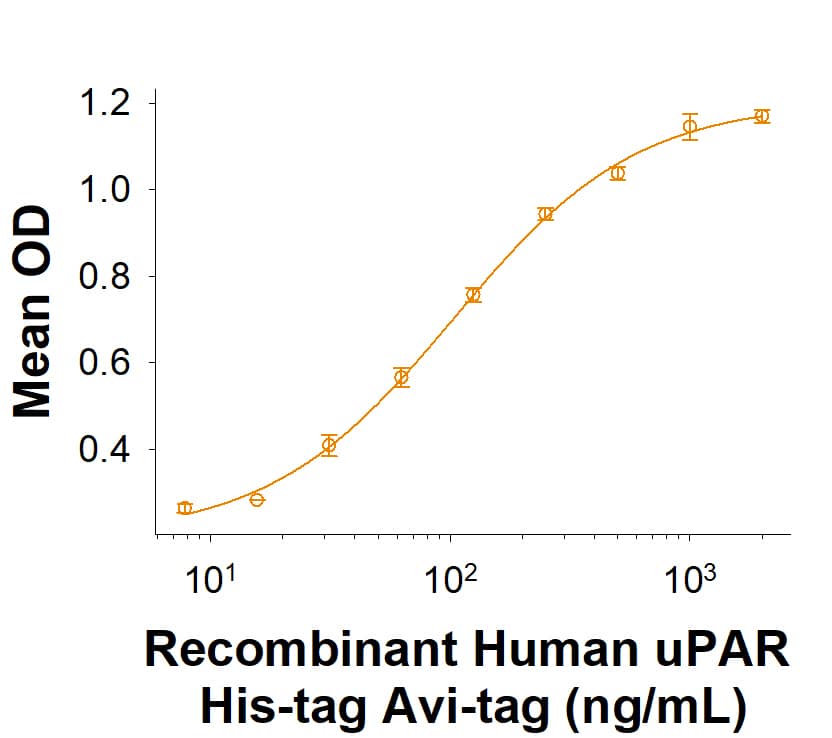Recombinant Human uPAR His-tag Avi-tag Protein, CF
R&D Systems, part of Bio-Techne | Catalog # AVI807

Key Product Details
- R&D Systems HEK293-derived Recombinant Human uPAR His-tag Avi-tag Protein (AVI807)
- Quality control testing to verify active proteins with lot specific assays by in-house scientists
- All R&D Systems proteins are covered with a 100% guarantee
Source
Accession #
Structure / Form
Conjugate
Applications
Product Specifications
Source
| Human uPAR (Leu23-Arg303) Accession # Q03405.1 |
HHHHHH | Avi-tag |
| N-terminus | C-terminus |
Purity
Endotoxin Level
N-terminal Sequence Analysis
Predicted Molecular Mass
SDS-PAGE
Activity
When Recombinant Human u-Plasminogen Activator (uPA)/Urokinase (Catalog # 1310-SE) is immobilized at 5 μg/mL (100 μL/well), the concentration of Recombinant Human uPAR His-tag Avi-tag (Catalog # AVI807) that produces 50% of the optimal binding response is 40‑240 ng/mL.
Scientific Data Images for Recombinant Human uPAR His-tag Avi-tag Protein, CF
Recombinant Human uPAR His-tag Avi-tag Protein Binding Activity
When Recombinant Human u-Plasminogen Activator (uPA)/Urokinase (Catalog # 1310-SE) is immobilized at 5 µg/mL (100 µL/well), Recombinant Human uPAR His-tag Avi-tag (Catalog # AVI807) binds with an ED50 of 40-240 ng/mL.Recombinant Human uPAR His-tag Avi-tag Protein SDS-PAGE
2 μg/lane of Recombinant Human uPAR His-tag Avi-tag (Catalog # AVI807) was resolved with SDS-PAGE under reducing (R) and non-reducing (NR) conditions and visualized by Coomassie® Blue staining, showing bands at 47-54 kDa.Formulation, Preparation and Storage
AVI807
| Formulation | Lyophilized from a 0.2 μm filtered solution in PBS with Trehalose. |
| Reconstitution | Reconstitute at 1 mg/mL in PBS. |
| Shipping | The product is shipped at ambient temperature. Upon receipt, store it immediately at the temperature recommended below. |
| Stability & Storage | Use a manual defrost freezer and avoid repeated freeze-thaw cycles.
|
Background: uPAR
The urokinase-type Plasminogen Activator (uPA) is one of two activators that converts the extracellular zymogen plasminogen to plasmin, a serine protease that is involved in a variety of normal and pathological processes that require cell migration and/or tissue destruction. uPA is synthesized and released from cells as a single-chain (sc) pro-enzyme with limited enzymatic activity and is converted to an active two-chain (tc) disulfide-linked active enzyme by plasmin and other specific proteinases. Both the scuPA and tcuPA bind with high-affinity to the cell surface via the glycosyl phosphatidylinositol-linked receptor uPAR which serves to localize the uPA proteolytic activity. The enzymatic activity of scuPA has also been shown to be enhanced by binding to uPAR. Independent of their proteolytic activity, the uPA/uPAR interaction also initiates signal transduction responses resulting in activation of protein tyrosine kinases, gene expression, cell adhesion, and chemotaxis. uPAR can interact with integrins to suppress normal integrin adhesive function and promote adhesion to vitronectin through a high affinity vitronectin binding site on uPAR. uPAR cDNA encodes a 335 amino acid (aa) residue precursor protein with a 22 aa residue signal peptide, five potential N-linked glycosylation sites and a C-terminal GPI-anchor site. An alternate spliced variant of uPAR encoding a secreted soluble form of uPAR also exists. Human and mouse uPAR share approximately 60% aa sequence identity and the receptor-ligand interaction is strictly species-specific.
References
- Dear, A.E. and R.L. Medcalf, Eur. J. Biochemistry (1998) 252:185.
Long Name
Alternate Names
Gene Symbol
UniProt
Additional uPAR Products
Product Documents for Recombinant Human uPAR His-tag Avi-tag Protein, CF
Product Specific Notices for Recombinant Human uPAR His-tag Avi-tag Protein, CF
For research use only

